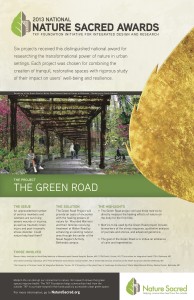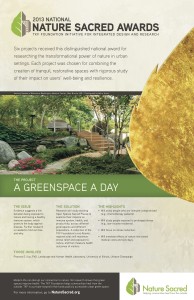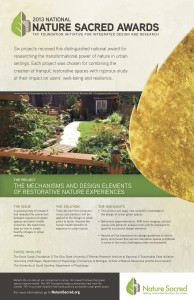
The Biophilic hypothesis, first introduced by Edward O. Wilson in his book Biophilia, suggests that we as humans have an instinctive response to other living things. Since that time, numerous studies have shown the beneficial effects of nature as a healing force. Ever since Roger Ulrich’s (TKF Foundation project team member, A Nature Place) 1984 ground breaking paper “View Through a Window May Influence Recovery From Surgery” (Science, April 27, 1984 v224 p420(2)) demonstrated that hospital patients with a window view of nature had a quicker recovery time and more positive recovery notes than those who’s window looked out on a brick wall, scientists have been trying to determine exactly what causes this positive response to nature.
According to Fred Foote, project leader for TKF Foundation The Green Road, when working with injured veterans, one goal is to use nature to help turn off the stress response in order to get the body to heal. The problem becomes, how do we measure exactly what it is that nature is doing on a biological level.
“The feeling we get from nature is a whole body experience but traditional metrics apply to only one part of the body,” Foote said. For example, heart rate is often used as an indicator of stress but the healing may be taking place in the liver or the legs. Foote said that new ways of measuring the body’s response to nature are required. This includes advanced genomics analyzing how certain genes turn on and off when exposed to nature, language analysis which can show healing, non-invasive methods of gathering sweat and saliva and other methods of biological analysis.
“We need to measure several biomarkers at once to get a single expression of stress,” Foote said.

Frances (Ming) Kuo, project leader, TKF Foundation A Green Space a Day, is also looking at how nature can impact stress levels and how reducing stress can impact immune response. Research in the Netherlands and Japan has shown that time in nature can produce a healthy immune response. Through her research with low-income populations who are exposed to long-term stress, biologically immune-compromised chemotherapy patients, and individuals with robust immune systems, Kuo hopes to determine what specifically it is about nature that reduces stress and improves immune functioning.
One of the more innovative methods Kuo will be using is to geographically map nature sites to help tie specific health benefits to these spaces.
While A Green Space a Day and The Green Road project work to measure our biological response to nature, Marc Berman, project leader, TKF Foundation, Mechanisms and Design Elements, is trying to determine precisely what level and intensity of green space is needed to affect the people in them. For example, how many trees are needed to get the mental health benefits of nature. In the process Berman’s team will be trying to determine if our response to nature will be as simple as the abundance of the color green in nature or is does nature provide something more complicated such as specific fractal patterns that affect us as humans.

According to Berman though, “There’s a grander application where, if we can really quantify these things, we can put a dollar value on how much nature really benefits us and that might impact where we allocate monetary resources.”
Foote agreed when he said that when we can qualify how nature heals, when we can show the science behind it, we can truly start to affect policy. He added that environmental groups are taking notice of the work they are doing as it has the potential to have a big influence in how we as a society view and care for nature.
“We know in our hearts that nature heals. There is a certain artificiality in the effort to say it doesn’t,” Foot said. “We hope to penetrate what is really going on and as we do, I’m sure we will be surprised by many things. For every road that closes, another will open.”
